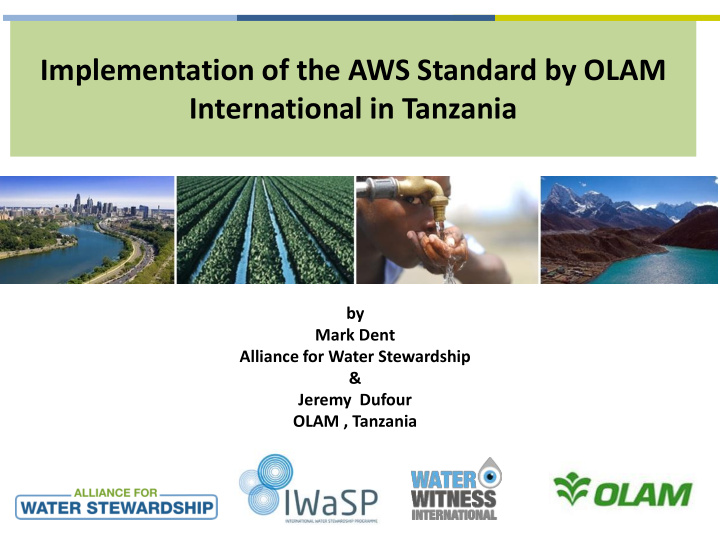



Implementation of the AWS Standard by OLAM International in Tanzania by Mark Dent Alliance for Water Stewardship & Jeremy Dufour OLAM , Tanzania
AWS FOUNDING PARTNERS 2
WHY A WATER STEWARDSHIP STANDARD? 3 Establish global consistency of approach Drive transparency Engage diverse stakeholders Provide credible recognition Connect global with local Create coherence Framework for locally-appropriate action Globally-consistent outcomes
AWS STANDARD: OUTCOMES 4 GOOD WATER GOVERNANCE SUSTAINABLE WATER BALANCE IMPORTANT WATER-RELATED AREAS GOOD WATER QUALITY
MULTI-STAKEHOLDER PROCESS 5
ISEAL CREDIBILITY PRINCIPLES 6 • developed and agreed upon in 2013 to drive greater quality and consistency amongst standards and also help buyers, procurers and other users of certification to understand what to look out for.
SYSTEM DOCUMENTATION 7 Released July 2015
Olam International Limited Olam origins Born in 1989 65 countries 16 platforms Singapore 44 products (listed since 2006) 4Mn+ smallholder farmers 23,000+ employees Nigeria 15,9Mn tons of products (1989) 20,8Bn S$ sales revenue At Olam, we believe that profitable growth needs to be combined with a way of doing business. It involves creating value on an ethical , s ocially responsible and environmentally sustainable basis – we have called this ‘ Growing Responsibly . ’ Sunny Verghese CEO, Olam Int’l
Aviv Coffee Plantation in Tanzania Located in Upper Ruvuma sub-basin (5 th largest basin in East Africa); 1,100ha of irrigated Arabica coffee plantation (directly from Ruvuma River); Original Water Use Permit granted in March 2012 for 60,000m 3 /day; Annual water requirements of 6.4Mn m3 for primary processing and drip irrigation; Naturally dynamic physical environment of regular flood and drought events.
Catchment Context & Shared Basin Water Risks Olam internal standards and policies; Development of sub-catchment IWRM Plan; Upstream/Downstream inter-dependency; Reduction in natural flow (Climate Change); Increasing basin demand from domestic use and agriculture; Need for maintaining Min Env. Flow; Weak governance and financial means; Creation of platform of dialogue to cool down stakeholder relationships; Increase in storage capacity at Aviv. How to harvest benefits from work already accomplished into a framework allowing continuous improvement and allowing scalability?
Implementing the AWS Standard - Methodology • Gap analysis • Action plan – closing the gap • Mock assessment • Input and outcome tracking • Guidance & training • Audit certification
Positive changes emphasized by AWS Improved water quality management & pollution control - improved erosion control & reduced soil loss; - investment in water quality monitoring; - comprehensive pollution control; - addressing basin-wise pollution risks. Sustainable water balance & equitable use - proactive approach to conflict resolution - protecting environmental flow needs; - strengthening compliance. Water supply, sanitation and hygiene provision - safe and sufficient supply of potable water; - provision of hygienic conditions. Improved governance & systemic changes - improved coordination to manage water risks; - constructive advocacy at national level.
Costs & Benefits to all stakeholders Long term security of business operations; Direct contribution to improved water security Reduced likelihood of regulatory actions; for 14,000+ people; Long-term cost savings; Actions on water management towards Demonstrable credibility as a responsible water communities and outgrowers; steward; Reduced risk of pollution; Ability to scale best practice across global Equitable water use amongst users; value chain; New investment towards sub- Enhanced staff capacity. basin water management. BAS ASIN OLAM OLAM STAK AKEHOLDE LDERS RS the AWS standard helped strengthening GO GOVERNM VERNMENT ENT and structuring existing water stewardship efforts Advocacy for improved water resource management in Tanzania; Private sector alignment and compliance with water policy and legislation framework (WRM, 2009); Targeted support for the formation of Water User Association; Strategic beach-head for stewardship in the region (Training and uptake).
Challenges in implementation Exposure to new risks Overlap with internal management systems ‘Sustainability gap’ – adaptability to Tanzanian context Readiness from other stakeholders Cost of certification / Availability and readiness of certifiers
Want a copy… AWS is a cost effective and powerful mechanism for water stewardship and delivery of improved water security in Africa. Instigates new investment and new partnerships . Significant potential in governance challenged catchments. Scalable and sustainable business model. Outreach, support and quality of application are crucial. Knowledge management essential to track and share benefits and evolve the system for Africa.
Recommend
More recommend